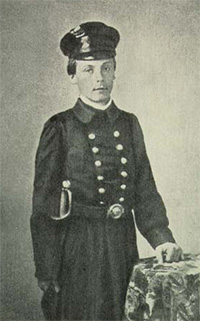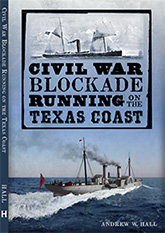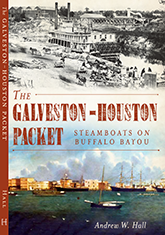 James Morris Morgan (right, 1845-1928) was a 17-year-old Acting Midshipman in the Confederate Navy, serving aboard the ironclad Chicora at Charleston, when he received orders sending him abroad, where he would later join the crew of the commerce raider C.S.S. Georgia. First, though, he had to get safely out of the Confederacy. One of his fellow passengers on the run to Bermuda was the celebrated naval officer and oceanographer, Matthew Fontaine Maury (1806-73). As Morgan would recall decades later in his memoir, Recollections of a Rebel Reefer, Maury’s presence aboard the runner would prove to be a fortuitous circumstance.
James Morris Morgan (right, 1845-1928) was a 17-year-old Acting Midshipman in the Confederate Navy, serving aboard the ironclad Chicora at Charleston, when he received orders sending him abroad, where he would later join the crew of the commerce raider C.S.S. Georgia. First, though, he had to get safely out of the Confederacy. One of his fellow passengers on the run to Bermuda was the celebrated naval officer and oceanographer, Matthew Fontaine Maury (1806-73). As Morgan would recall decades later in his memoir, Recollections of a Rebel Reefer, Maury’s presence aboard the runner would prove to be a fortuitous circumstance.
[George Alfred] Trenholm owned many blockade-runners — one of them, the little light-draft steamer Herald, [1] was lying in Charleston Harbor loaded with cotton and all ready to make an attempt to run through the blockading fleet. Commodore Maury, accompanied by his little son, a boy of twelve years of age, and myself, whom he had designated as his aide-de-camp for the voyage, went on board after bidding good-bye to our kind friends. About ten o’clock at night we got under way and steamed slowly down the harbor, headed for the sea. The moon was about half full, but heavy clouds coming in from the ocean obscured it. We passed between the great lowering forts of Moultrie and Sumter and were soon on the bar, when suddenly there was a rift in the clouds, through which the moon shone brightly, and there, right ahead of us, we plainly saw a big sloop-of-war!
There was no use trying to hide. She also had seen us, and the order, “ Hard-a-starboard,” which rang out on our boat was nearly drowned by the roar of the warship’s great guns. The friendly clouds closed again and obscured the moon, and we rushed back to the protecting guns of the forts without having had our paint scratched. Two or three more days were passed delightfully in Charleston; then there came a drizzling rain and on the night of the 9th of October, 1862,[2] we made another attempt to get through the blockade. All lights were out except the one in the covered binnacle protecting the compass. Not a word was spoken save by the pilot, who gave his orders to the man at the wheel in whispers. Captain [Louis M.] Coxetter, who commanded the Herald, had previously commanded the privateer Jeff Davis, and had no desire to be taken prisoner, as he had been proclaimed by the Federal Government to be a pirate and he was doubtful about the treatment he would receive if he fell into the enemy’s hands. He was convinced that the great danger in running the blockade was in his own engine-room, so he seated himself on the ladder leading down to it and politely informed the engineer that if the engine stopped before he was clear of the fleet, he, the engineer, would be a dead man. As Coxetter held in his hand a Colt’s revolver, this sounded like no idle threat. Presently I heard the whispered word passed along the deck that we were on the bar. This information was immediately followed by a series of bumps as the little ship rose on the seas, which were quite high, and then plunging downward, hit the bottom, causing her to ring like an old tin pan. However, we safely bumped our way across the shallows, and, plunging and tossing in the gale, this little cockleshell, whose rail was scarcely five feet above the sea level, bucked her way toward Bermuda. She was about as much under the water as she was on top of it for most of the voyage.
Bermuda is only six hundred miles from Charleston; a fast ship could do the distance easily in forty-eight hours, but the Herald was slow: six or seven knots was her ordinary speed in good weather and eight when she was pushed. She had tumbled about in the sea so much that she had put one of her engines out of commission and it had to be disconnected. We were thus compelled to limp along with one, which of course greatly reduced her speed. On the fifth day the weather moderated and we sighted two schooners. To our surprise Captain Coxetter headed for them and, hailing one, asked for their latitude and longitude. The schooner gave the information, adding that she navigated with a “blue pigeon” (a deep-sea lead), which of course was very reassuring.[3] We limped away and went on groping for Bermuda. Captain Coxetter had spent his life in the coasting trade between Charleston and the Florida ports, and even when he commanded for a few months the privateer Jeff Davis he had never been far away from the land. Such was the jealousy, however, of merchant sailors toward officers of the navy that, with one of the most celebrated navigators in the world on board his ship, he had not as yet confided to anybody the fact that he was lost.
On the sixth day, however, he told Commodore Maury that something terrible must have happened, as he had sailed his ship directly over the spot where the Bermuda Islands ought to be! Commodore Maury told him that he could do nothing for him before ten o clock that night and advised him to slow down. At ten o’clock the great scientist and geographer went on deck and took observations, at times lying flat on his back, sextant in hand, as he made measurements of the stars. When he had finished his calculations he gave the captain a course and told him that by steering it at a certain speed he would sight the light at Port Hamilton by two o clock in the morning. No one turned into his bunk that night except the commodore and his little son; the rest of us were too anxious. Four bells struck and no light was in sight. Five minutes more passed and still not a sign of it; then grumbling commenced, and the passengers generally agreed with the man who expressed the opinion that there was too much d___d science on board and that we should all be on our way to Fort Lafayette in New York Harbor as soon as day broke. At ten minutes past two the masthead lookout sang out, “Light ho!”; and the learned old commodore’s reputation as a navigator was saved.

[1] Stephen R. Wise’s Lifeline of the Confederacy identifies Herald as a 222-foot-longh iron-hulled sidewheeler built on the Clyde in 1858. Herald was an extremely successful runner, making twelve successful round voyages before being lost trying to run into Old Inlet, near Wilmington, at the end of 1863.
[2] Wise gives this date as October 12.

 James Morris Morgan (right, 1845-1928) was a 17-year-old Acting Midshipman in the Confederate Navy, serving aboard the ironclad Chicora at Charleston, when he received orders sending him abroad, where he would later join the crew of the commerce raider C.S.S. Georgia. First, though, he had to get safely out of the Confederacy. One of his fellow passengers on the run to Bermuda was the celebrated naval officer and oceanographer, Matthew Fontaine Maury (1806-73). As Morgan would recall decades later in his memoir, Recollections of a Rebel Reefer, Maury’s presence aboard the runner would prove to be a fortuitous circumstance.
James Morris Morgan (right, 1845-1928) was a 17-year-old Acting Midshipman in the Confederate Navy, serving aboard the ironclad Chicora at Charleston, when he received orders sending him abroad, where he would later join the crew of the commerce raider C.S.S. Georgia. First, though, he had to get safely out of the Confederacy. One of his fellow passengers on the run to Bermuda was the celebrated naval officer and oceanographer, Matthew Fontaine Maury (1806-73). As Morgan would recall decades later in his memoir, Recollections of a Rebel Reefer, Maury’s presence aboard the runner would prove to be a fortuitous circumstance.
![]()





One additional side note about this — I came across this account in The Civil War: An American Illiad, by Otto Eisenschiml and Ralph Newman. I was all ready to post it but, wanting to cite the original source, I looked up Morgan’s memoir. Sure enough, the whole account I had originally read and was about to post was much shorter than what Morgan actually wrote. Eisenschiml and Newman edited and condensed it without making it clear to the reader they’d done so. Worse, some of the edits damaged the original content. For example, this line from Morgan, about Captain Coxetter and the revolver:
was changed to read,
This is a bad edit; leaving out the phrase “before he was” makes the second version completely non-nonsensical in context.
American Illiad was originally published in the 1940s, and I’ve seen this sort of thing done before during that period, taking an original, first-hand account and chopping and re-editing it without letting on. Authors who do that should be put up against a wall.
The lesson here, as always, is go back to the original source. It bears repeating, and repeating, and repeating. . . .
if the engine stopped before he was clear of the fleet, he, the engineer, would be a dead man
Sounds like the captain was a graduate of the Darth Vader school of management.
Captain Coxetter had spent his life in the coasting trade […] , and even when he commanded for a few months the privateer Jeff Davis he had never been far away from the land.
So … I’m guessing that, in late 1862, blue-water captains who were willing to risk running the blockade were in short supply — at least in the Charleston area? Even with the incredible pay, and a share in the profits? (Not to mention the opportunity to do a little personal trade in luxury goods.)
Was this because the increasing effectiveness of the blockaders at Charleston was causing the more experienced officers to move to Wilmington, where the odds of getting in and out were better, or do you think Coxetter had some kind of an in with Trenholm?
This could well be an exaggeration. It’s happened before. 😉
The blockade at Charleston was tough, though. It was (I think) the first Confederate port to be blockaded, and had a very strong naval presence offshore throughout the war. (You might say that, for the U.S. Navy, the blockade of Charleston was personal.) There weren’t any blockade runners who were actually hanged, but there was a lot of loose talk and rhetoric cast around about prosecuting both civilian blockade runners and the officers of C.S. naval vessels (e.g., Semmes) as pirates. It never actually happened, but in 1862 it was still in the wind, at least in some peoples’ minds.
The coasting trade was very demanding sailing, because the waters were so difficult to navigate. It was easier sailing to cross the Atlantic to Europe due to the Gulf Stream. But going down the North American Atlantic Coast to Florida and then along to New Orleans — it was really difficult and dangerous. You could make your career fairly quickly in the coastal packet trade because shipmen didn’t like serving on them — whereas captains and officers did, because the voyages provided them many opportunities to increase their personal wealth.
Why yes, I have just been reading a book. 🙂
Love, C.
All true. It’s very odd, who got involved in blockade running. There’s a riverboat pilot captain I talk about in the Buffalo Bayou book, John Sterrett, who got hands-on involved in blockade running near the end of the CW. I haven’t really figured that out yet, because there are only a handful of sources that mention this, but they seem to point to something fundamental, not a passing connection. I don’t think he had great personal wealth, and it’s difficult to see particular expertise he had with that sort of business, apart from his (numerous) trips running riverboats from the mouth of the Mississippi to Galveston. He was not a blue-water seaman by any stretch.
One thing, though: I imagine it doesn’t require quite the same degree of navigational skill to hit Cuba that it does to find Bermuda. (Assuming he was running his cargos into Havana.)
I didn’t mean to disparage Capt. Coxetter qualities as a seaman, either. Unreliable charts, shifting bars and sudden storms make coasting a dangerous proposition. I just found it kind of interesting that the owner of the ship — and whatever other backers of the venture there were — either didn’t bother to find out whether he had the requisite skills for blue-water sailing, or they were so hard up for a captain that they didn’t care. Did Coxetter lie to them, or did the subject just never come up? We’ll likely never find out, of course, but you have to admit it’s fun to speculate.
This is true if you’re setting out from Galveston: you slide into the Gulf Stream loop that takes you right to Havana. Very different than if you are sailing down the Atlantic coast, where you have to navigate the Florida Keys and so on — this was equally true for getting to Bermuda from the east coast.
All tricky waters. It was at Bermuda one of the earliest colonizing ships wrecked on their way to Virginia.
Love, C.
Maybe a consortium got a privateer built and recruited him to captain it?
About 1863 DeBow tried to get the Confederacy interested in building a combination of riverboat and rail system from Texas to various cotton cities on the other side of the Mississippi, to transport the cotton back to Texas, where it could be smuggled out on privateers setting off from there, while on the return east bringing Texas food supplies and so on to the beleaguered army.
Love, C.
I never knew that the threat of hanging extended to the blockade runners, too. It’s hard to see how such a thing could be justified, when the case for executing commerce raiders as pirates was already pretty tenuous. Of course, there’s a bit of difference between arguing it as an academic matter, and betting your life on the reasonable behavior of your adversary in a bitter war.
AFAIK it was ever seriously considered, but that didn’t stop the papers (North and South) from shrieking about it, or men like Coxetter from convincing themselves that they, personally and individually, were causing Old Abe to lose sleep at night.
In Coxetter’s case, to be fair, he was both a Southerner and a known mariner to the Federals, so he really would probably end up spending a lot more time in confinement than (say) a British citizen would — they were normally detained long enough to give evidence in the resulting prize case and then cut loose (often to start all over again).
This isn’t exactly on topic, but I don’t know how else to let you know about this exhibit of Civil War paintings by Confederate painter and soldier, Conrad Wise Chapman. Among his series of Civil War paintings available for view on the Richmond Museum of the Confederacy website is a two-man submarine. These paintings are not hung the museum, so online or other reproductions is how you can see them.
The site is here.
The NY Times has up yesterdy as its Disunion column one about Chapman; the author demonstrates a remarkable ignorance about art and artists in both north and south of mid-nineteenth century, but if you’d like to see it anyway, here it is.
Love, C.